Visit our Bread Recipes page for more fantastic homemade breads!
Bread with soup. Bread for toast. Bread to sop up the last streaks of sauce or gravy or pan juices. I suppose you might be able to survive without bread, but you sure can’t live without it. A big, fat, puffy, chewy, golden loaf of homemade bread is just about the best thing that could possibly happen to your day.
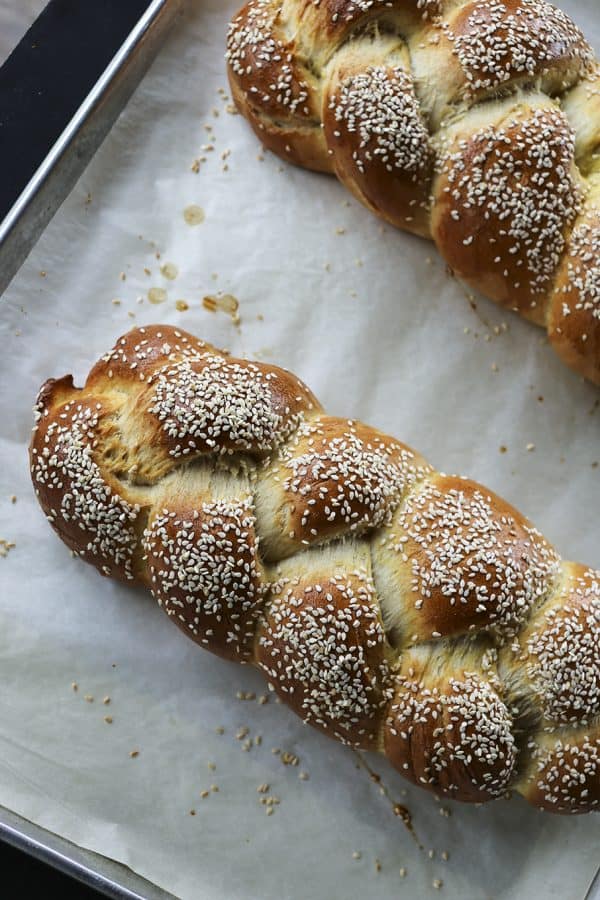
This is not one-hour or no-knead, but is so worth your time. This is another one of those foods that make you want to gnaw off your own foot while it’s cooking; It smells so good that you just can’t help yourself. When you tear a hot corner from this loaf and watch a cold pat of salted butter melt down into the soft crumb you’ll go weak in the knees. Assuming you haven’t eaten past your knees, that is…
Fresh from the oven and ripped into hunks, this bread is exactly what you want to sop up soups, sauces, dressings, gravies and pan juices. If you are a patient, forbearing, big-picture type person and you let it cool completely, this slices beautifully for sandwiches or toast.
This is The Minions’ favorite bread. They like that it yields two mega-sized loaves. They love that I top one with just sesame seeds and the other with sesame seeds, poppy seeds, onion flakes, and garlic flakes. They live for the times I tell them they can tear off industrial sized pieces from the loaf that’s dressed like an everything bagel. Butter is applied liberally. There are animal noises. Crumbs fly. They wait, slightly more patiently, for the sesame loaf to cool. They slice quarter-inch thick pieces of bread and like them toasted on one side with a top-hat of blueberry jam.
On the nights that I make them wait, they mill around the kitchen aimlessly, standing silently behind me like little ghosts waiting… waiting… waiting… making their way to the table and half-heartedly helping themselves to the whatever-else-I’m-serving then pouncing when the bread basket gets to them.
This is a bread of beauty; golden brown, crispy crust topped with crunchy seeds (and perhaps spices) and a soft, yielding interior. It is another gem of a recipe from the King Arthur Flour Company and their top notch baker’s test kitchen.
I’ve been making this bread for somewhere near ten years- ever since this recipe appeared printed in the pages of their horribly tempting catalogue. It’s a hard recipe to mess up beyond edibility. I’ve accidentally left the dough to rise overnight. I’ve hurried it along and forgotten the second rise.
I’ve brushed and topped it with exactly nothing at all. I’ve substituted bread flour for all-purpose flour out of necessity. And every single time it’s wonderful.
It’s a very forgiving bread to make if you’re nervous about working with yeast or dough, as I have accidentally proven time and again.
Here’s a comforting bit of knowledge about yeast. If you don’t have a warm place to let the dough rise, don’t worry! It will still rise, it’ll just take longer.
Sometimes much longer. Just be sure to keep it lightly covered to prevent the surface of the dough from drying. Do you want to see how very easy the whole process is? Watch this quick video!
Please try this. Pretty please. With sesame seeds on top.
Sesame Semolina Bread
Gently adapted from King Arthur Flour Baker’s Catalogue.
Scroll to the bottom for an easy-print version of this recipe!
To Shape the Dough:
Turn the dough out onto a clean surface and form into a neat mass. Divide the dough in half, then divide each half into 3 pieces. Cover three of the pieces with a towel while working with the other three.
Pat one piece into a rough oval. Use the side of your hand to press an indentation along the length of the dough piece.
Fold the dough together along the length of the indentation.
Roll lightly with the hands to form a thick rope between 12 and 14 inches long. Repeat with the other two pieces so that you have 3 ropes of roughly equal length. Line them up in parallel with the ends facing you.
To Braid the Dough:
Gently grasp the end of the rope on the far left. Lift it to about the center, leaving the far end on the counter, cross it over the rope nearest to it and lay it down. Now grasp the end of the piece on the far right and lift it to about the center, leaving its far end on the counter, cross it over the (now) center rope (which is the first one you moved) and lay it down.
This is the manoeuver you will repeat – far left over center, far right over center, and so on- until you have ends too short to continue. At that point, pinch the ends together and tuck under the braid. Now go back to the center of the loaf and finish braiding the loaf toward the top. When you reach the ends, pinch together and tuck under.
The whole process looks like this:
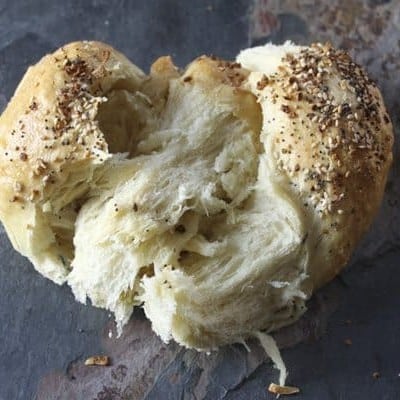
Ingredients
- 4 cups all-purpose flour 1 pound, 1 ounce, by weight
- 2 cups semolina flour 11 1/2 ounces, by weight
- 3 teaspoons SAF or instant yeast
- 3 teaspoons kosher salt
- 4 tablespoons sugar or non-diastatic malt powder
- 4 tablespoons extra virgin olive oil
- 2 cups lukewarm water 16 ounces, by weight or volume
- 1 beaten egg
- Optional Toppings:
- Sesame seeds
- Poppy seeds
- Onion flakes dehydrated
- Garlic flakes dehydrated
- Coarse salt
Instructions
To Mix Dough By Hand:
- Add all ingredients except the egg and toppings to a large mixing bowl and stir together with a sturdy wooden spoon until you form a shaggy but cohesive dough. Let the dough rest for 30 minutes, covered with a clean towel. Turn out onto a lightly floured counter top and knead until smooth and elastic, about 10 minutes. Transfer dough to a clean bowl, cover with a damp towel and let rise in a warm, draft-free place until doubled in size, about 2 hours.
- !To Mix Dough By Stand Mixer:
- Add all ingredients except the egg and toppings to the work bowl of your stand mixer fitted with the dough hook. Turn mixer onto the lowest setting and mix until a shiny, elastic dough forms. Remove the bowl from the mixer, cover the bowl with a damp towel and let rise in a warm, draft-free place until doubled in size, about 2 hours.
- !To Mix Dough By Bread Machine:
- Add all ingredients except the egg and toppings to the pan of your bread machine that has been fitted with the dough paddle(s). Set the bread machine on the dough setting and press start. When the cycle is completed, proceed with shaping...
- !To Shape the Dough:
- Turn the dough out onto a clean surface and form into a neat mass. Divide the dough in half, then divide each half into 3 pieces. Cover three of the pieces with a towel while working with the other three.
- Pat one piece into a rough oval. Use the side of your hand to press an indentation along the length of the dough piece. Fold the dough together along the length of the indentation and roll lightly with the hands to form a thick rope between 12 and 14 inches long. Repeat with the other two pieces so that you have 3 ropes of roughly equal length. Line them up in parallel with the ends facing you.
- !To Braid the Dough:
- Either line a half sheet pan with parchment or set a baking stone out to use.
- Gently grasp the end of the rope on the far left. Lift it to about the center, leaving the far end on the counter, cross it over the rope nearest to it and lay it down. Now grasp the end of the piece on the far right and lift it to about the center, leaving its far end on the counter, cross it over the (now) center rope (which is the first one you moved) and lay it down. This is the manoeuver you will repeat - far left over center, far right over center, and so on- until you have ends too short to continue. At that point, pinch the ends together and tuck under the braid. Now go back to the center of the loaf and finish braiding the loaf toward the top. When you reach the ends, pinch together and tuck under. Transfer the braid to the parchment lined sheet or the baking stone. Cover the loaf lightly and let rise in a warm place until puffy in appearance and about doubled in size.
- Preheat oven to 400°F. Whisk the egg until very loose. Paint generously onto the risen bread braids and sprinkle the braids with desired toppings.
- Bake for 18-26 minutes or until your preferred shade of golden to deep brown and firm on top. Turn the oven off, prop the door open a little (two inches, if you can make your door behave) and let cool for at least an hour. Or tear into the loaves with your teeth. I won't tell.
Nutrition
Nutritional information is an estimate and provided to you as a courtesy. You should calculate the nutritional information with the actual ingredients used in your recipe using your preferred nutrition calculator.
did you make this recipe?
Make sure to tag @foodiewithfam on Instagram and #hashtag it #foodiewithfamily so I can check it out!
This post was first published March 4, 2011.
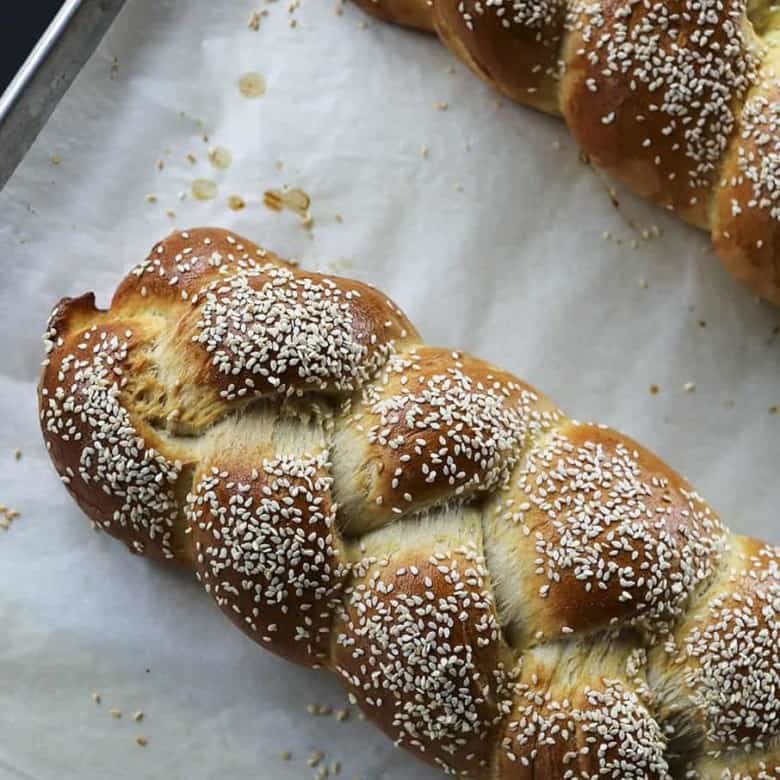
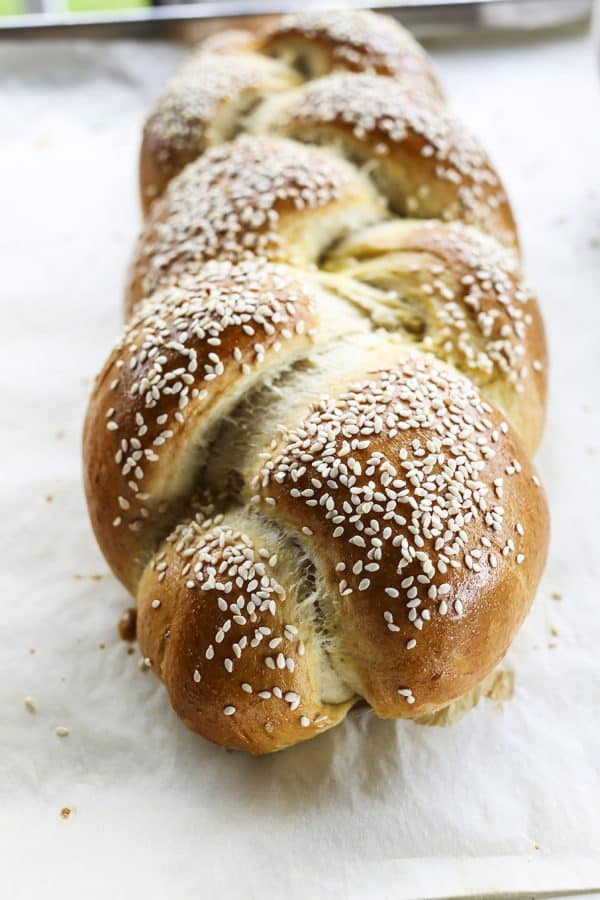
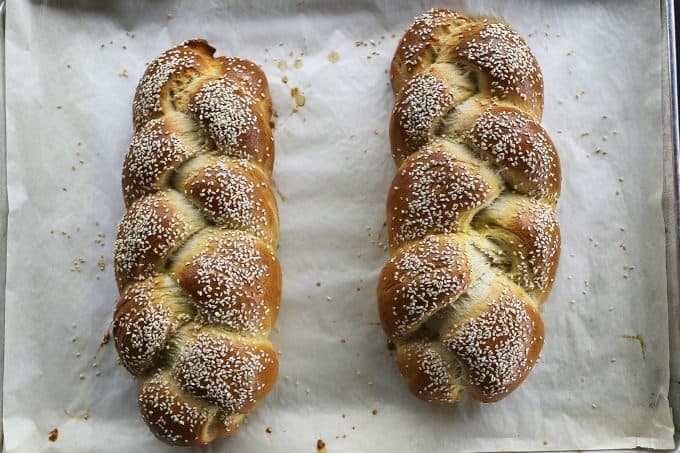
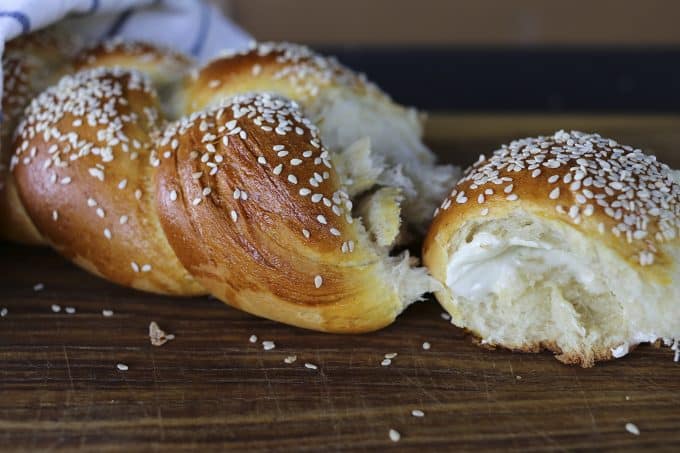










Reader's Thoughts...
Heb says
Great recipe-bread turned out really nicely and will make again.
Vicki C says
Thank you for this amazing recipe – I keep coming back to it! It’s better than what I can get in the store, and the whole family loves it. I found the recipe when I was searching for something to make with sourdough starter. No, that’s clearly not part of this recipe, so not sure why it was listed! But, I sneak a half cup of starter in with the initial ingredients, and it works beautifully.
Rebecca says
Thank you so much for taking the time to rate the recipe and let me know you love it, Vicki!! I love the idea of tossing in some starter with it!
JAQUELINE HOELTGEBAUM says
Hello Rebecca!
This recipe looks delicious. I’m looking for a recipe with semolina, I never made it, but I have a lot of curiosity. I’m starting now in the world of baking!
I know that this is your recipe and that you tested it with these ingredients, but let me ask you, without offending, can I replace sugar with honey?
Will the texture change a lot? The appearance of your bread is so inviting.
Rebecca says
Hi Jaqueline- That is not offending at all! That’s a great question! I think it would work beautifully to replace the sugar with honey. It may make your dough a wee bit stickier to work with, but it’ll yield a delicious bread and one with a shelf life that is slightly longer than if made with sugar!
Chocolate Lady says
Made this lovely bread and everyone devoured it!! You have the best recipes and commentary!! Many thanks!!
Rebecca says
Oh thank you so much, Chocolate Lady! I appreciate you taking the time to rate the recipe and let me know you love it.
barbara says
Wow, so easy to make and produces two gorgeous braided semolina loaves! Nothing fancy to this recipe, I actually left it in the fridge overnight after the first rise cuz it was too late to bake at that point. Let it warm up to room temp this a.m. and continued with the braiding and second rise, and the finished loaves are beautiful covered in traditional sesame seeds. My kitchen smells heavenly! Great recipe.
Rebecca says
I’m so glad you love it, Barbara! Thanks for taking the time to rate the recipe and let me know how forgiving the dough is!
Rich says
It sounds like when your use the stand mixer you don’t do two rises. You cut and shape the dough and braid it then let it rise once. Is that accurate? Also do you notice a difference in taste between sugar and non-diastatic malt?
Rebecca says
Hey Rich! There is actually a first rise of about 2 hours or until it is doubled in bulk as specified in the recipe. 🙂 I do notice a subtle difference between malt and sugar, but they’re both great results!
Richard T Leschek says
Thanks, My family loves the recipe. I did do the first 2 hour rise as you stated. The bread reminds me of the Sicilian bread from D’Orsi’s bakery in port Reading, New Jersey that I used to get when I lived near there. I think I will try the MALT next time.
Rebecca says
That’s wonderful, Richard! I’m so glad you all love it. 🙂
Elizabeth says
What is the nutrition data serving size ?
Rebecca says
Hi Elizabeth! It is 1/12 of the final yield of the loaves. 🙂
Dave says
I baked this bread today, and followed your recipe exactly (except I cut recipe in half after discovering i was almost out of flour). It turned out great. It was so beautiful it was a shame to eat it, but I did.
Rebecca says
Thanks so much for taking the time to rate the recipe and let me know how well it turned out for you, Dave! I’m so glad it worked well for you!
Emily Smith says
Hi!
Can you tell me approximately how long the second rise takes? I’m trying to plan out my Valentine’s Day Dinner and my time is limited as I’m working that day. Also, does this bread freeze well?
I’m so excited to try this! Looks exactly like the bread I grew up eating in Brooklyn. ❤️
Rebecca says
Hi Emily! I hope you love this bread as much as we do!! As for the second rise, it’s dependent on a lot of factors. If your room is warm (say, 70-ish F or warmer), it might take 20 minutes. If it’s cooler, it might take closer to 40 minutes. But the temperature of the dough and humidity of the room also come into play. If you’re concerned about it being done in time, I’d start it earlier in the day and let it rest. You can always warm it back up gently in a moderate oven. 🙂 Happy Valentine’s Day!
Emily Smith says
This bread recipe is amazing! Very similar to Brooklyn bread and I can’t believe I can make it myself! Thank you for sharing this recipe, I will be making it often. By the way, it does freeze well too! <3
Rebecca says
You’re so very welcome, Emily! Thanks for taking the time to rate the recipe and let us know you love it!
Michaela says
Do you have t[ braid it or can you just form it as an ‘Italian bread’ and bake
Rebecca says
Hi Michaela- Feel free to make free form, unbraided loaves!
Donna says
I made this recipe and followed every step exactly. But my loaves did not rise in the oven. The were small and dense. The dough raised well the first time. After I braided the loaves they rose a little (probably not double) I waited 1 1/2 hours so I thought they wouldn’t rise anymore and would rise some more while baking. But they didn’t rise any more during the baking time. I am new to making bread so I want to learn what I may have done wrong.
Rebecca says
Hi Donna! Let’s start with a couple of questions. How did you measure your flour? Did you go by weight or by volume? And if you used a measuring cup, did you dunk the cup down into the flour or did you fluff the flour first, then use a spoon to sprinkle it over the measuring cup, then level it? Let’s see where we get with those questions before we move on. 🙂
Leonora G Serino says
My daughter and I made this. It was amazing. Thanks so much for the recipe.
Rebecca says
I’m so glad you love it, Leonora!
Fabiana says
I made this last week and I will make it again tomorrow morning. This was outstanding. Thank you so much for sharing! 😘❤️
Rebecca says
Thank you so much for taking the time to rate the recipe and let me know you love it, Fabiana! I’m so glad!
Keri says
I found it dense and not as soft or airy as I hoped. I don’t have a stand mixer.. maybe I kneaded and rolled too much? Otherwise delicious!
Rebecca says
Hi Keri- You may have overkneaded it, but I’d first wonder whether you measured by volume (in measuring cups) or by weight (on a kitchen scale.) Which of those did you employ? That may help us nail down why your dough was dense. I’m guessing that you used measuring cups.
Peggy says
Hi is it possible to bake half the proportion by halving the recipes ? Any quantity needs to be adjusted differently ? Thanks.
Rebecca says
Hi Peggy- I’d say halving it will work great. 🙂
Karen says
Making your bread this morning. I did not see weather or not to bake bread on sheet pan or stone. I did have to go bake and look at your pictures. Annoying.
Rebecca says
Hi Karen- Luckily, either of those options would have yielded a delicious bread. I’ll go pop a note about that in the recipe card.
Francesca says
The dough looks dry. Is that normal? Also, I didn’t proof the dry yeast will that make a difference?
Rebecca says
Hi Francesca-
I’m afraid I can’t tell you if it looks normal without a photo. If you’d like to email me a photo, I’ll happily look it over. 🙂 My email address is available on the About page.
Chris says
My braids came out great, but when I let it double, the braids ripped a little. Was the dough too dry?
Rebecca says
Hi Chris- The likeliest culprits when braided bread does that are both braiding a little too tight and/or under-proofing the dough. Did the bread taste good?
Shira says
Hi, Do you think it’s possible to substitute the yeast with sourdough starter? Have you ever tried it?
Rebecca says
Hi Shira- I’m sure you can, I’ve just not tried it personally! It’d be a bit of a different process, for sure. If you play around with it a bit, please let me know how it goes for you!
Shira says
Ok, I’ve made it. Subbed the yeast with 160g %100 hydration whole rye sourdough starter. Bulk fermented in the fridge over night, proofed under the oven light for an hour. Everything else was done per your recipe. I’m pretty new at it so my hydration was a bit off and a bit too sticky for the shaping but it came out tall and delicious! Crusty, soft and chewy on the inside, perfect for pulling chunks or slicing. Thanks!
Rebecca says
That sounds spectacular, Shira! I may give that a go myself.
Cindy says
Currently going through the steps to make this semolina bread, I only had bread flour on hand so I substituted it for the all purpose. I only just now skimmed through the comments and noticed someone else mentioned using bread flour and you suggested needing for a longer time due to higher protein, but I already started proofing the dough. Is it too late to put it back on the stand mixer and let it knead a bit longer? I’m not exactly sure how it should look when it’s done kneading and am afraid to overknead. How many minutes would you say it takes for the stand mixer to knead the dough after mixing all ingredients? Sorry this was long winded, it’s my first time making bread.
Rebecca says
That’s okay, Cindy!! I’m sorry I didn’t see this sooner, but you would have been a-okay to let it keep proofing! Please check back in with me and let me know what you did and how it worked for you. I’m so thrilled that this was the recipe you used for your first go-round of bread baking!
Timmythehound says
What is a good internal temperature to bake the bread to?
Can we add egg to the dough like in other braided breads?
Rebecca says
Hi Timmy- 190°F is the perfect internal temp for this bread! And adding egg to the dough… do you mean a beaten egg to the dough? Or braided around the eggs like in Italian Easter breads? I wouldn’t add egg directly to the dough- it’s a lovely texture as is. 🙂 As for braiding around it, I suppose that’d work. 🙂